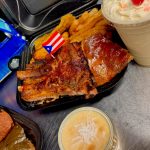Diana Krall, sexy and smart at the Riverside
Krall and her great band spread the jazz tent over standards and rock songs alike.

An intimate moment at the Riverside Theater. L-R: Anthony Wilson, Karriem Riggins, Diana Krall, Robert Hurst. All photos by Erik Ljung for the Pabst/Riverside.
Monday night at the Riverside Theater, Diana Krall joked about making a children’s album — a “smoky, sultry, scotch-infused” children’s album.
It’s funny because it’s true — not the children’s album part, the “smoky, sultry,” part. I don’t know about the
scotch.
I won’t kid you, I love that sexiness and it has something to do with her success. I mean, she packed the sweltering Riverside in July in Milwaukee, and everyone stayed in steam-room conditions through a 75-minute set with no intermission.
Sex appeal is a great thing, but not the only great thing about Diana Krall. Very high musicianship frees her formidable musical imagination. Krall doesn’t improvise all that radically while she’s singing. She doesn’t launch scat tangents in the way of Ella Fitzgerald, say. Mostly, she retains the shape of the melodic line but transposes it, to put it into intriguing, unexpected relationships with the harmony. She’s far more adventurous with her piano playing. Monday night, Krall crafted one convincing solo after another. No idle cocktail noodling for her; Krall’s improvisations were short stories with beginnings, middles and ends.
Given the extended treatments of old standards (Exactly Like You, ‘Deed I Do, Cheek to Cheek), bossa nova (Summer Samba, Quiet Nights of Quiet Stars) and newer tunes (Dylan’s A Simple Twist of Fate, Tom Waits’ Jockey Full of Bourbon), her solos were more like chapters in novels. Her co-authors were Anthony Wilson, guitar; Robert Hurst, bass; and Karriem Riggins, drums. These jazz virtuosos listened acutely to Krall and one another. They commented and supported with exquisite awareness, and they put their solo turns in context of what had come before. The four have in common a gift for rhythmic wit.
Except for clever, preconceived endings, their arrangements seem to be open-ended. On several occasions during this 14-song set, you could hear them moving into uncharted territory, feeling their way toward an evolving form, changing the mood and even altering the chord changes. They never failed in this; the music often turned suspenseful but never turned incoherent.
The most amazing transformation began with a brilliant, impossibly fleet and light treatment of Irving Berlin’s Cheek to Cheek. Over the course of several rounds of improvisation, the mood changed entirely, until Hurst landed on a heavy bass ostinato. Along with everyone else in the place, I couldn’t imagine how they would get back from there to the light fantastic of Heaven, I’m in heaven…
About that time, Krall sang: Here come old flat top He come groovin’ up slowly… Krall and company took off from Fred-and-Ginger‘s ballroom and landed on the Beatles’s Come Together and made it all sound plausible. What imagination, what nerve. What fun.





















Very well written, and a fine compliment to Ms. Krall!
Thanks for commenting, Brandon. We do try, here at TCD. — Strini
To say the truth, I had never even heard of this lady before; but your VERY nice review sent me scurrying to YouTube and a marvelous video she made – “Just The Way You Are”. Great stuff. Great writing. Thanks, Tom.
You have captured in words my exact reactions on a visceral level to Diana Krall. Before I had ever seen her picture, I had a vision of a 40-60 year old attractive woman-of-the-world who had seen it all, done it all, etc. How a person of her tender years manages to not only generate such emotions within herself but also evoke them in her audience is truly a gift. She is the musical equivalent of Talisker, a smoky, elegant, lingering single malt scotch from the Isle of Skye.
And then there is her piano…